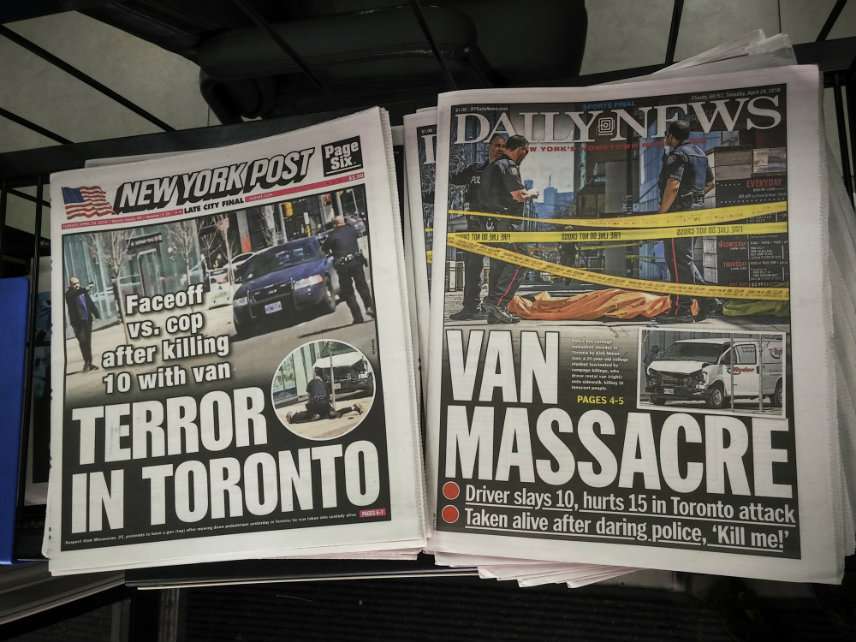Weapons Are Just Tools. It's People Who Are Dangerous.
Restricting guns-or vans, knives, or planes-won't make the world safer. The Toronto van attack reminds us peril lies in people with bad intent, not with how they get it done.

As Toronto cleans up the bloody mess caused by Monday's van attack, it's worth noting that Alek Minassian, who has been charged in the attack, appears to be a very dangerous person.
You'll note that I said dangerous person. I didn't refer to the vehicle the murderer drove for two kilometers along Toronto's Yonge Street, killing 10 people and injuring another 15. The van, after all, was only a tool the murderer used to fulfill his malevolent intent. Once he decided to harm other people, he then chose the van as a means of achieving that goal.
The van was effective in accomplishing harm, but it was only a tool—it's the person who used it who is at fault. That's a point that gets lost in a lot of our debates, probably because it's easier to stigmatize things than it is to root out human evil.
Firearms are the tools that most commonly come to mind when people think of mass attacks, leading many people to call for ever more restrictive gun laws as a means of reducing the body count. But firearms are certainly not the only weapon used, nor are they necessarily the most effective means of committing mayhem.
Look at recent tragedies in France. In Paris, nine attackers, using guns acquired from illegal sources in defiance of France's restrictive laws, killed 130 people and injured 413 in November 2015. But a single attacker, using a freight truck, killed 86 people and injured 458 others in Nice the following year. As in Toronto, he drove a vehicle through a crowd of pedestrians, implementing his intent with a tool that suited his purpose.
In the wake of the February murder of 17 students by a disturbed former student at Marjory Stoneman Douglas High School in Parkland, Florida, several survivors have themselves been weaponized by organizations seeking tighter legal restrictions on firearms. Their efforts ignore not just the fact that "shooting incidents involving students have been declining since the 1990s," as researchers at Northeastern University put it, but the fact that the bloodiest mass killing ever to take place at a U.S. school didn't require the use of firearms. The 1927 Bath School Massacre ended the lives of 44 people, including 38 children, in an explosion of dynamite that had been diverted from farming use. The murderer in that case was an embittered school board member, throwing doubt on "solutions" that rely on the authorities to do right by the people under their protection.
Airliners were the weapons of choice on 9/11, hijacked and crashed into buildings by Islamic terrorists. They killed almost 3,000 people and injured thousands more with the tools they thought would get the job done. American officials responded with a couple of useful changes, but mostly, characteristically, they focused on the tools that were used rather than the evil people who chose them.
Fertilizer and diesel fuel were the weapons of choice in the 1995 Oklahoma City bombing. Blended together into an explosive, basic agricultural supplies—a common fertilizer and a fuel found at most filling stations—the bombers took the lives of 168 people and injured several hundred more. It was the deadliest terrorist attack on U.S. soil until 9/11.
And fuel alone was the weapon of choice for the lethal crime that killed 87 people at New York City's Happy Land Social Club in 1990. Angered by being bounced from the establishment earlier in the evening, the arsonist took his revenge with nothing more than a container of gasoline. "It was the deadliest fire in the city in 79 years," the New York Daily News reports.
In every one of these crimes, the danger existed as soon as somebody decided that the best way to vent one grievance or another was to attack other people. The killers chose available tools that would effectively get the bloody job done. If the selected tool had somehow been rendered unavailable, the intent would have remained and no doubt found its expression in another way.
After the 9/11 attacks, both Kip Hawley, a former TSA administrator, and Bruce Schneier, a security expert, say two changes since the terrorist attack have made a difference: one is reinforcing cockpit doors, and the other is that "passengers…now know that they may have to fight back," as Schneier put it. After the Germanwings Flight 9525 incident of 2015, in which a pilot locked himself in the cockpit before deliberately crashing the plane, it's not even clear that reinforcing those doors was a net good. In any event, both changes focused not on the tools of convenience but on how we respond to the assailants. "Regulations are always playing catch-up, because terrorists design their plots around the loopholes," Hawley says.
It's frustrating to admit, but it's true: Nothing is more dangerous than evil people who can turn anything at hand to bad intent.


Show Comments (99)